This lesson builds on the stitches that were covered in Learn to Crochet: Lesson 2. If you missed Lessons 1 or 2 or ever want to refer back to them in the future, I have added links to the lessons under the Crochet Tutorials and Resources tab above. Also under the tab is a list of crochet abbreviations and symbols for your reference. I have also included the stitch abbreviation and symbol in parentheses after each stitch as it is introduced.
Half Double Crochet (hdc)
As discussed in Lesson 2, when beginning a row of half double crochets, you need to chain 2 before working the first stitch (Fig. 1a). Most patterns will count this beginning chain as your first stitch.
To work a half double crochet, wrap the yarn over your hook from back to front (Fig. 1b), insert hook into the specified stitch, yarn over again and pull a loop through the stitch (there will be 3 loops on your hook; Fig. 1c), yarn over and pull through all 3 loops on hook (half double crochet made; Fig. 1d). Continue working half double crochets across row (Fig. 1e).
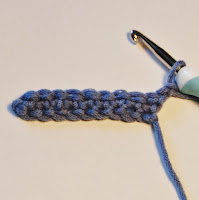
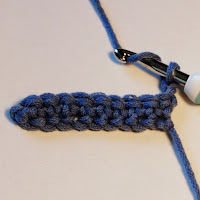
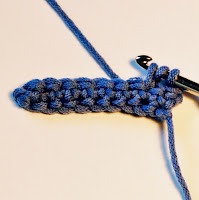
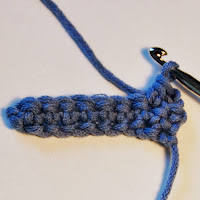

If you were following a pattern, this row would read like this:
Row 1: Ch 2 (counts as first stitch), 1 hdc in each st across, turn – 9 sts.
Double Crochet (dc)
To begin a row of double crochets, you need to chain 3 before working the first stitch (Fig. 2a). Again, this is usually counted as your first stitch. To work a double crochet, wrap the yarn over your hook from back to front (Fig. 2b), insert hook into the specified stitch, yarn over again and pull a loop through the stitch (there will be 3 loops on your hook; Fig. 2c), yarn over and pull through 2 loops (2 loops will now be on your hook; Fig. 2d). Yarn over again and pull through remaining 2 loops (double crochet made; Fig. 2e). Continue working double crochets across row (Fig. 2f).





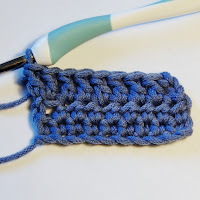
If you were following a pattern, this row would read like this:
Row 2: Ch 3 (counts as first stitch), 1 dc in each st across, turn – 9 sts.
Treble Crochet (tc)
To begin a row of treble crochets, also called triple crochets, you need to chain 4 before working the first stitch (Fig. 3a). Again, this is usually counted as your first stitch. To work a treble crochet, wrap the yarn over your hook twice (Fig. 3b), insert hook into the specified stitch, yarn over again and pull a loop through the stitch (there will be 4 loops on your hook; Fig. 3c), yarn over and pull through 2 loops (3 loops will now be on your hook; Fig. 3d). Yarn over again and pull through 2 loops (2 loops will now be on your hook; Fig. 3e). Yarn over again and pull through remaining 2 loops (treble crochet made; Fig. 3f). Continue working treble crochets across row (Fig. 3g).

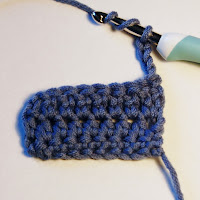

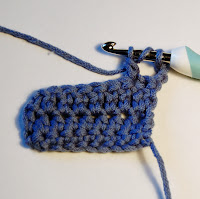
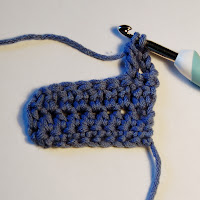

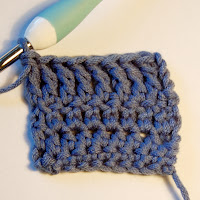
If you were following a pattern, this row would read like this:
Row 3: Ch 4 (counts as first stitch), 1 tc in each st across, turn – 9 sts.
Slip Stitch (Sl st)
The smallest stitch is called a slip stitch. The slip stitch is mainly used to join two pieces of crochet together or to work across a row without adding height. To work a slip stitch, insert your hook into the specifies stitch (Fig. 4a), draw a loop through the stitch and right through the loop on your hook (slip stitch made; Fig. 4b). Continue working slip stitches across row (Fig. 4c).
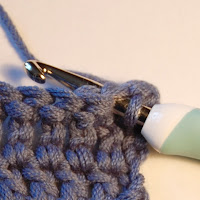
Fig. 4b
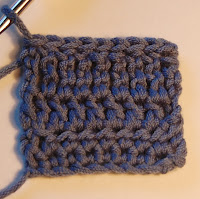
If you were following a pattern, this row would read like this:
Row 4: Work 1 Sl st in each st across – 9 sts.
Following a Pattern
Patterns may seem overwhelming at first, but if you have worked up the stitches here and in Lesson 2, you have basically followed a pattern!!
So far, to get to where we are to form the swatch in Fig. 4c, we have worked the following pattern:
Ch 10
Foundation Row: Starting in 2nd ch from hook, work 1 sc in each ch across, turn – 9 sts.
Row 1: Ch 2 (counts as first stitch), 1 hdc in each st across, turn – 9 sts.
Row 2: Ch 3 (counts as first stitch), 1 dc in each st across, turn – 9 sts.
Row 3: Ch 4 (counts as first stitch), 1 tc in each st across, turn – 9 sts.
Row 4: Work 1 Sl st in each st across – 9 sts.
Congratulations!! You have learned the basic crochet stitches and have followed your first pattern!!!
There are many, many more stitches in crochet. Stitch dictionaries are great resources for learning new stitches. My favorites are The Complete Photo Guide to Crochet by Margaret Hubert (Creative Publishing International, 2010), Crochet Stitches VISUAL Encyclopedia by Robyn Chachula (Wiley, 2011), and The Crochet Answer Book (Storey Publishing, 2005)by Edie Eckman.
Please let me know if you have any questions at all, and I will do my best to answer them.
Next up is Lesson 4 – What Is Gauge?

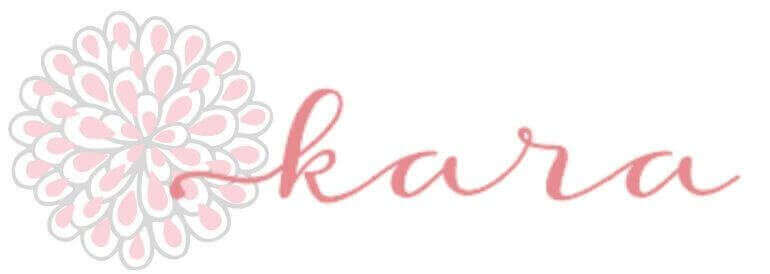
Hi 🙂
Thank you for your tutorials. I’ve been crocheting for 45+ years, but it’s always nice to brush up on terminology, stitches etc. I notice some stitches are different than what I learned. What I learned as a DC is different than yours. Please tell me what this stitch is..going from when you have the 3 loops on your hook. I would pull thru 1, then 2 and 2. That’s what we called a DC.
THANK YOU so much for your help!!
This is really helpful! Especially the following a pattern information. I’ve seen quite a few crochet tutorials without that and patterns intimate me!
I am so glad you found it helpful, Coby! Don’t be intimidated by patterns … once you get the hang of them it becomes second nature 🙂
Girl, I would love to learn hot to crochet one day. It overwhelms me just looking at it. My hubby says I have not patience. I agree 😉 Thanks so much for sharing at Toot Your Horn Tuesday 🙂
I need to catch up on lessons 1&2! I have all the materials to get started, but have yet to get going….new to your blog and maybe after a few more post, I’ll have a chain going in no time!
LOL! I can’t wait to hear how you make out 🙂
When you say that the chain one makes before starting a row (is it one for single crochet, 2 for half double, 3 for double??)is the first stitch, does that mean that one would use that at the end to make the last stitch in the row?
I hope this makes sense to you! If not, don’t worry. I will be the first to admit that I an spatially challenged.
Hi Baye, Yes, it makes perfect sense … if the pattern is counting the beginning chain as a stitch (and they usually do), then you would stitch into that chain on your next row just as if it was a regular stitch. Does that make sense? And yes, it is one chain to continue with single crochets, two for half double crochets, three for double crochets, and four for treble crochets. Hope that helps 🙂